Tip Run Eging in Okinawa
Tip Run Eging.
I’ve been studying this game recently.
I like the sensitivity of the game.
But most of all, it’s the squid as food!!!
The main target is Bigfin Reef Squid, Sepioteuthis lessoniana.
The amino acids, Umami components, is the richest in all the squids in Japan. It’s the high-end squid, rarely seen in grocery stores, only consumed in expensive restaurants and sushi bars. Sweet and full of flavor and the meat is tender and elastic.
Delicious in all cooking styles. Sashimi, grill, soup, deep-fry, stir-fry, steam, and whatever. You can’t go wrong. And the best part is that it doesn’t lose much quality by freezing.
The other common catch by eging here in Okinawa is Reef Cuttlefish, Sepia latimanus. It can grow to 50cm and more.
The taste is not as great as Bigfin Reef Squid. But many people like the texture especially in deep-fry.
Tip Run Eging was born in the mainland of Japan and the idea has come to Okinawa. But it needs to be adapted. Anglers here are exploring different setups and applications.
Field
The squid fields are much deeper here. In the mainland, it’s up to 30m usually. But in Okinawa, it’s usually 50m to 60m, sometimes as deep as 100m.
Target size
The squid size is a lot bigger. In the mainland it’s mostly around 1kg, rarely up to 3kg. Here in Okinawa, 2kg is the average. 3kg is common. Sometimes it grows up over 5kg.
Jig Weight
Because of the depth, the jig weight is bound to be heavier. In mainland, it’s mostly less than 30g, no more than 50g. Here in Okinawa, it’s 60g to 80g usually, sometimes up to 160g.
Boat Operation
A lot of times free drifting at 50m to 60m depth is hard to get to the bottom. Some boats operate with sea-anchor. Some with spanker.
Egi
Because of the target size, Egi becomes bigger. More hooks too. The most popular and proven jig here is Keystone Egi 5.0 (Left 3). It’s 20cm long. The right 3 jigs are size 3.5, normal size in the mainland. But the captains here are finding that there are sometimes that squids only take size 3.5.
Tackle
I have tried Tip Run Eging a couple times. The biggest I caught was 2.8kg. (The picture shows the other 1.2kg catch) I was using Slow Jerker 603-3, Daiwa Saltiga Z30, PE0.8, Keystone 5.0, 150g weight, at 60m+ depth.
I have bought Daiwa Emeraldas 76ML/H-S BOAT (spinning), matching with my favorite reef casting light game reel, Shimano Vanquish C3000 with PE0.8. Just like what Tip Run Eging anglers in the mainland say. But I was able to use this spinning tackle only when the current is loose. It was pretty windy, so I still had a 80g sinker. I liked the rod. But I felt that it was too much burden for my poor 3000 size reel. It was so much easier with overhead tackle.
So after 2 trips, I have decided that this is an overhead tackle game. It’s deep. It’s heavy. It’s a vertical game.
When I caught that 1.2kg squid with Slow Jerker 603-3, I was able to pick up the faint sign of the contact. It threw a couple of quick punches at the jig first, and I gently brought up the tip, still listening, then the weight of the jig felt lighter. “It held the jig.” I struck and got it hooked. I was happy to sense that for the first time.
So I became confident that Slow Jerker can do it. But I figured a longer and lighter rod will do better. I decided to bring in Beat Propagate Expert 702-2. I think this rod will do great.
And for the Daiwa spinning rod, I think I will reload Shimano 6000 with PE0.8 to match. It may be too big, but my Twin Power 4000 has PE2.0 on it and I need it for my reef casting game for blue emperors.
So, I think I’m focused now. Looking for another trip!
Ike-Jime Squid
Of course, we close the squid by Ike-Jime.
Close the squid instantly. Don’t let it suffer.
But it’s a lot simpler than fish.
First, close the ink sack with a string.
If you open the mantle on the funnel side, you see the ink sac. If you want to use the ink for your cooking (I do!), you want to keep it. The sac can open after death. Even if you don’t want to use the ink for your cooking, you want to close it because you don’t want to mess your cooler box.
After catching with the net, you want to treat it as gently as possible, so that the squid won’t spit out the ink to mess your close and your boat.
Then put in the icepick right between the eyes and point it up toward the body. The brain is there, between the eyes, a little toward the body. When you hit it, you’ll see the whole body turn white.
But you see in the picture that the tentacles haven’t turned white yet. Rooted in the brain, the nervous system is running toward to body and toward the tentacles.
Sometimes you hit the brain and the whole body turns white with one shot. But if the tentacles remain colored, you can point the icepick back down toward the tentacles, and you can break down the nervous system pretty easily.
Now it’s all white. It’s closed.
Here’s my 2.8kg catch.
Ready to go. But I can’t decide which parts to use for what cooking! Too many options!
Related Posts
2 Comments
Leave a Reply Cancel reply
Categories
- 1. SPJ (57)
- 1-1. Principles (9)
- 1-2. Techniques (11)
- 1-3. Setup (17)
- 1-4. FAQ (19)
- 1-5. Tackles (3)
- 1-6. Video Gallery (2)
- 2. Other Offshore Games (5)
- 3. Fishing Report (105)
- 3-1. Totos (25)
- 3-2. Readers (72)
- 4. Fish Cooking (19)
- 4-1. Iki-Jime (3)
- 4-2. The Art of Sashimi (5)
- 4-3. Recipe (7)
- 4-4. Seasoning (3)
- 5. Fishing Charter (6)
- Fish (12)



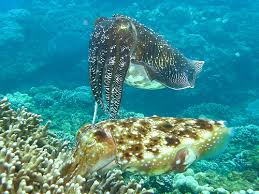
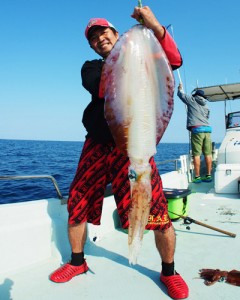
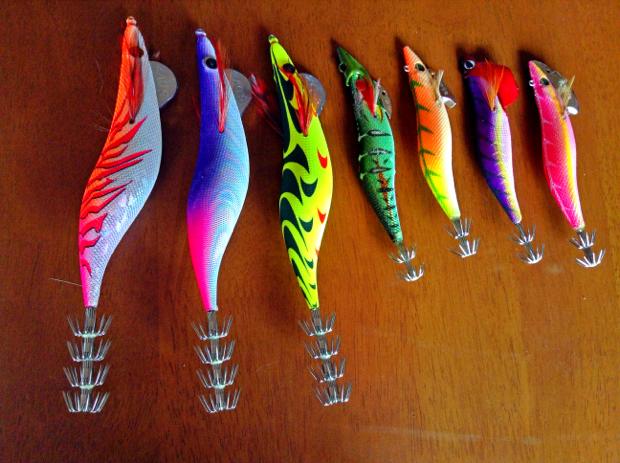
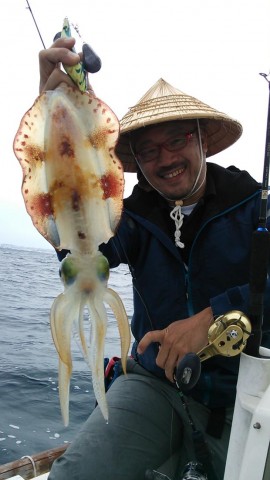
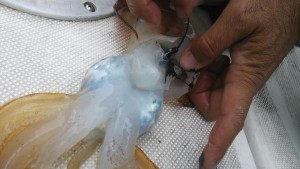


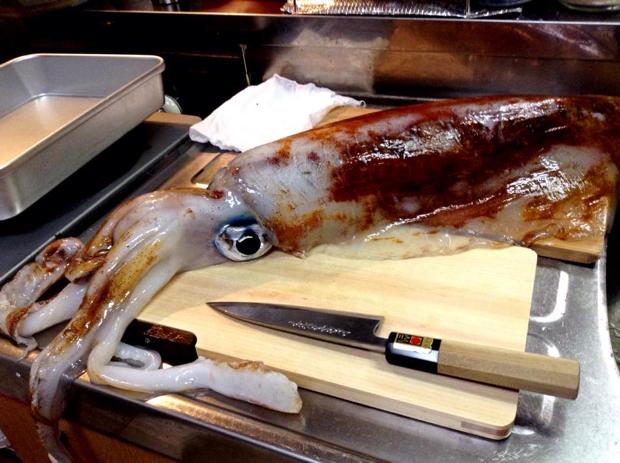


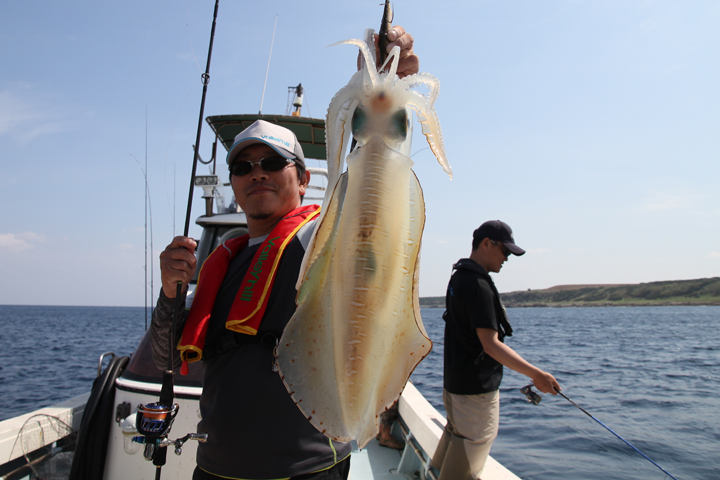
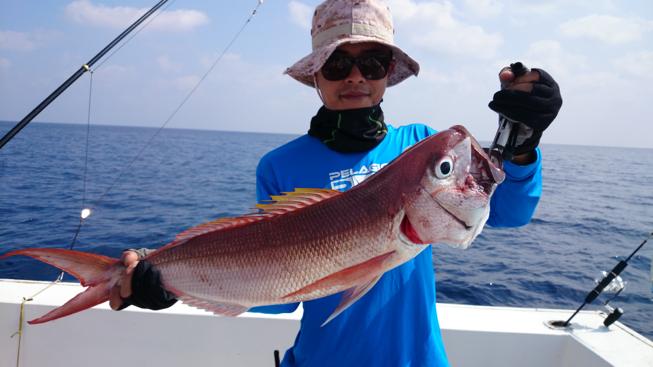
Hi Totos
We do a bit of squiding here in Fremantle Western Austaralia. We tend to fish shallower more like 2-10 meters. We also sometimes to use it as bait! However lots of people do eat it. What would Japanese people use the ink for? I would think most Australian would throw it away or maybe use it in Italian or Greek style dishes like risotto or black pasta.
Thanks
Tim
I really like your site and have found lost of very useful information especially with regards to catch care.
Hi Tim.
Oh, no, it’s a sin to throw away the squid ink!!! hahaha…
It’s common to use squid ink in soup. We also use it to season noodle like Italian people do with pasta. Squid ink makes the sauce rich, creamy and mind.
We made squid ink dumplings the other day and that was awesome too.
Here is the article on my other food blog.
http://fullofokinawa.com/squid-ink-dumpling/
Squid ink is rich in Mucopolysaccharide which makes your joints smooth, your blood vessels flexible and strong, maintains your skin health, and it’s also believed that it cures cancer. (Experimented on mouses.) Traditional Chinese medicine considers it to work for heart diseases.
Don’t throw it away. Try and see for yourself just once.